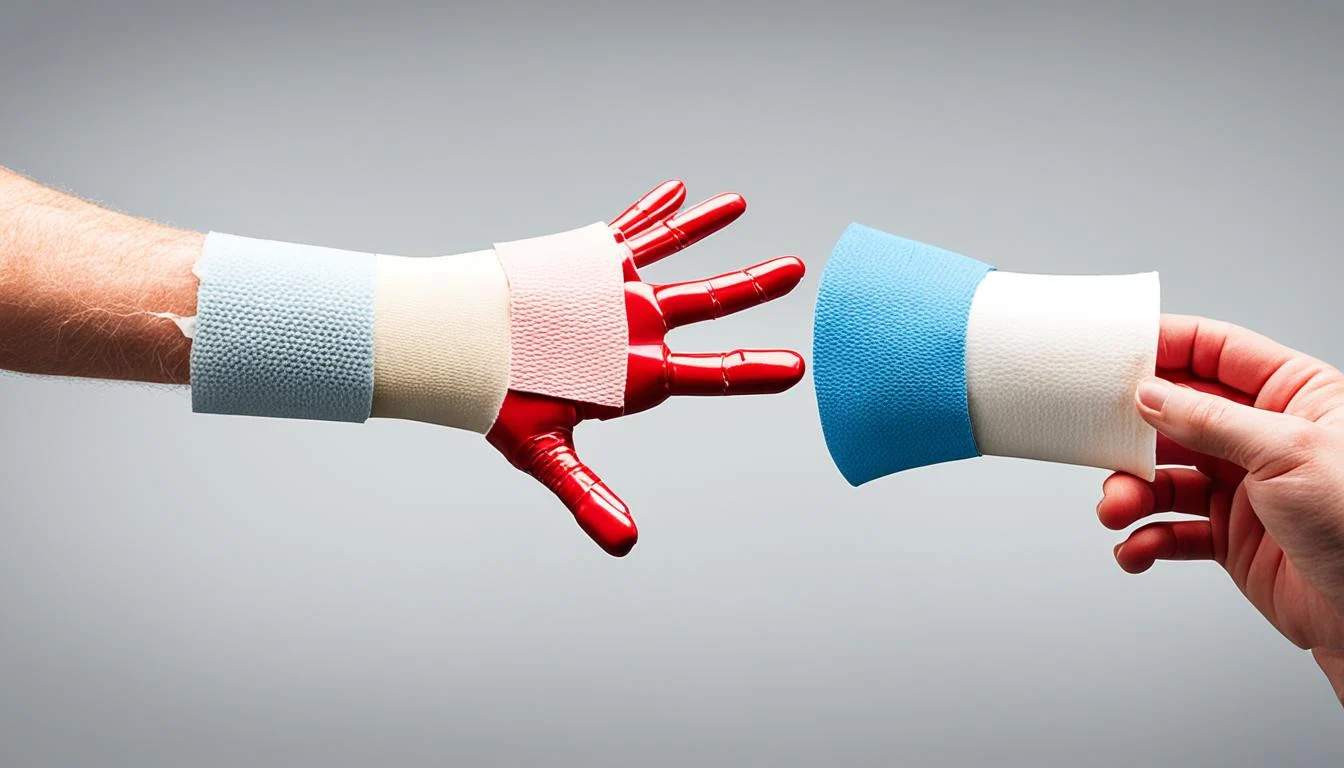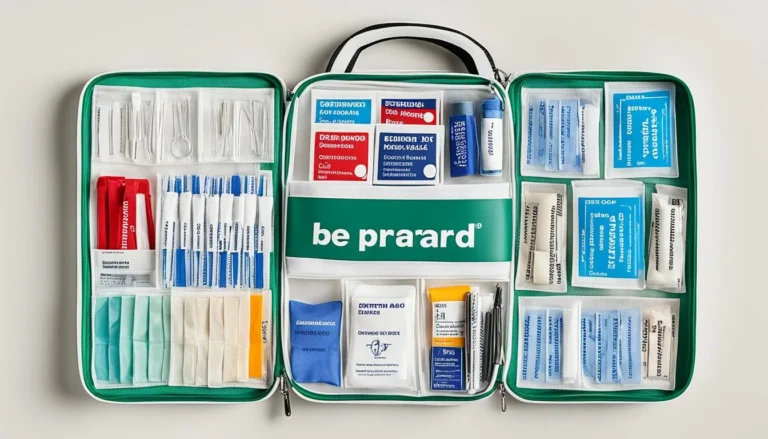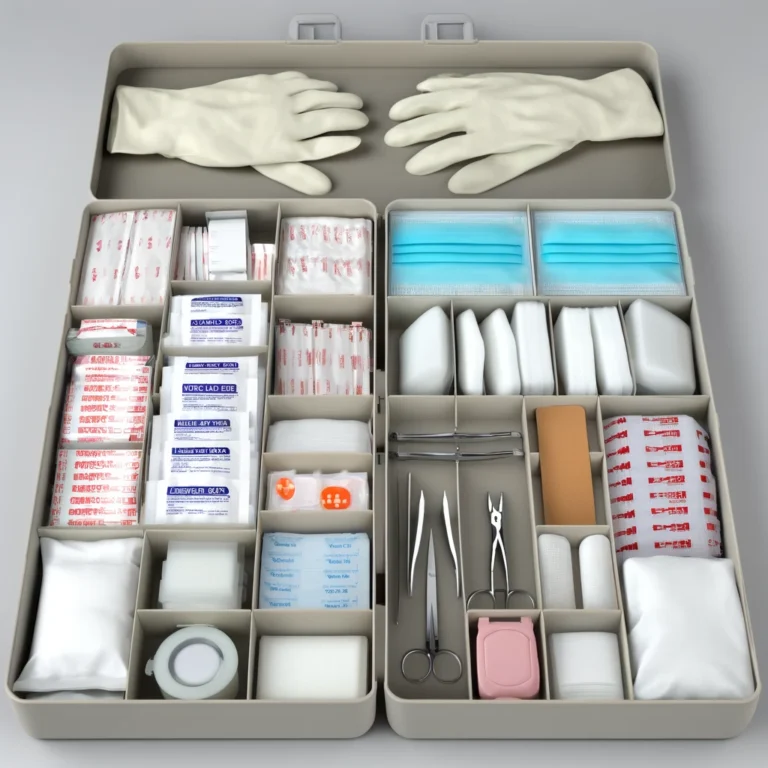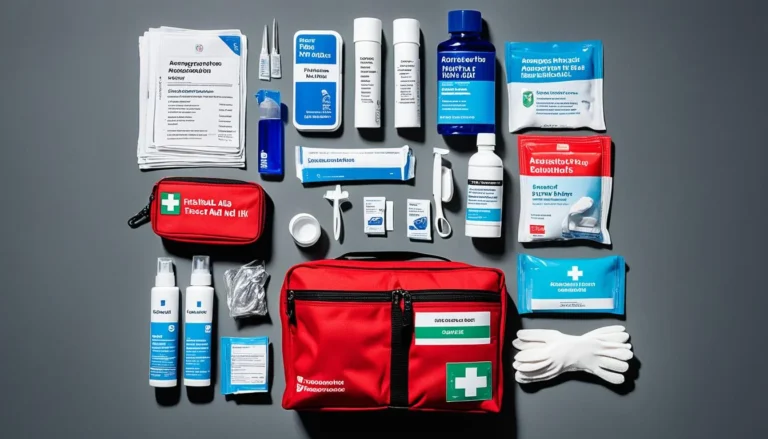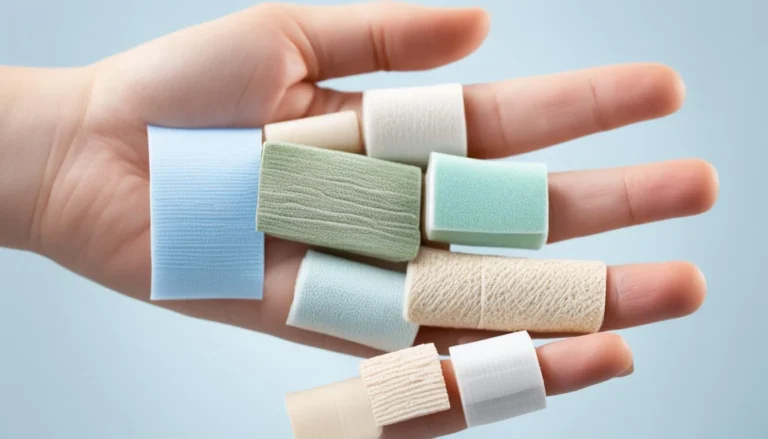Bandages vs Dressings: Wound Care Essentials
Understanding the difference between bandages and dressings is key in caring for injuries. Both are vital in the healing process. Bandages give support. Dressings help wounds heal by keeping them moist and warding off infection.
Choosing the right one for a wound’s type and how severe it is helps avoid infection. It also boosts the body’s efforts to heal itself. Picking the right gear for managing wounds means they get better faster.
To do this well, applying bandages and dressings right is essential. We need to know how each type helps the healing process. This includes their roles, variations, and when to use them.
Key Takeaways
- Knowing the difference between bandages and dressings is very important for good wound care.
- Bandages keep dressings in place and help stop bleeding, while dressings support the healing of wounds.
- Always wrap bandages loosely to avoid cutting off blood flow.
- Dressings are best when they keep wounds a bit wet to help them heal and stop infections.
- Choose what to use based on the type of wound, how bad it is, and the person’s health situation.
Understanding Wound Care: The Basics
Wound care is vital in managing health. It heavily relies on correct use of medical tools and methods. These help wounds heal by treating them initially and stopping infections.
The Role of Bandages and Dressings in Healing
Bandages and dressings are key for healing wounds. They cover the wound to help it heal. Bandages give limb support for injuries needing stillness. Dressings touch the wound directly, aimed at different wound types. They keep wounds moist and block out bacteria, which helps stop infections.
Types of Wounds and Appropriate Care Techniques
Every wound needs its own care method. The way we first treat a wound decides how well it heals. Here’s what to do:
- Abrasions: Clean the wound and use antibacterial cream before dressing it.
- Lacerations: Stitch or staple if needed, then put on a sterile dressing.
- Surgical Incisions: Change the dressing often to check for infections and ensure cleanliness.
- Burns: Cool, then cover with burn dressings for better healing.
Importance of a Hygienic Healing Environment
Keeping the area clean is key for good wound care. It helps prevent infections and makes medical tools more effective. Clean the wound regularly and change dressings right to avoid more infections and speed up healing.
Knowing how to treat a wound first, use the right tools, and keep it from getting infected are vital. Doing this well can really help wounds heal better. Below is a summary of the best dressings for different wounds:
| Wound Type | Dressing Type | Benefits |
|---|---|---|
| Abrasions | Hydrocolloid | Keeps the wound moist and protects from bacteria |
| Deep Cuts | Alginate Dressings | Highly absorbent and aids with blood clotting |
| Post-Surgical Sites | Foam Dressings | Provides thermal insulation and absorbs exudate |
| Burns | Hydrogel Dressings | Soothes the wound, hydrates, and facilitates pain-free dressing changes |
Types of Bandages and Their Specific Uses
Knowing the right bandage for a wound is key to good care. We’ll look at elastic, crepe, triangular, and cohesive bandages. Each is useful in its own way.
Elastic bandages are great for adjusting pressure and support. They’re stretchy and fit well on body parts. They’re a must in first aid for sports injuries.
Crepe bandages are breathable and give light pressure. They’re good for holding dressings and reducing swelling. They’re used a lot in quick first aid and after surgery.
Triangular bandages can do many jobs. They make excellent arm slings or big pads for stopping heavy bleeding. They’re key in quick first aid where you might not have many supplies.
Cohesive bandages stick to themselves, so you don’t need pins. They keep dressings safe on joints that move a lot. This stops the dressing falling off while allowing the joint to move.
| Bandage Type | Primary Use | Key Benefit |
|---|---|---|
| Elastic Bandages | Compression and support for sprains | Flexibility and adjustability |
| Crepe Bandages | Securing dressings, mild compression | Softness and breathability |
| Triangular Bandages | Slings for arms, emergency pads | Versatility in emergency use |
| Cohesive Bandages | Securing dressings especially on moving parts | Self-adherence, no need for fasteners |
Choosing the best bandage improves healing and comfort. Whether it’s a small injury at home or professional care, using the right bandage helps a lot. It can really change how well the wound heals.
Different Dressings for Optimal Wound Recovery
It’s key to know about different dressings to treat and heal wounds well. Each one has its job and is good for certain kinds of wounds.
Gauze dressings are very versatile. They help clean and cover wounds. This makes them a must-have in first-aid kits. On the other hand, hydrocolloid dressings are great for healing wounds. They keep the wound moist, which helps tissue grow back quicker.
If a wound should be left alone to heal, non-adherent pads are best. They don’t stick to the wound, making changing the dressing less painful. Transparent films have a special job. They protect the wound and let doctors see how it’s healing without taking off the dressing.
| Type of Dressing | Main Use | Benefits |
|---|---|---|
| Gauze Dressings | Cleaning and covering wounds | Highly absorbent, versatile |
| Hydrocolloid Dressings | Creating a moist healing environment | Speeds up healing, reduces pain |
| Non-Adherent Pads | Protecting the wound without sticking to it | Eases dressing changes, prevents damage to new tissue |
| Transparent Films | Protection and monitoring of wounds | Barrier against bacteria and water, allows visual inspection |
Choosing the right dressing depends on the type of wound and how it’s healing. Each dressing can really help the healing process if used correctly.
Bandages vs Dressings: Situational Appropriateness
When looking after injuries, knowing when to use bandages or dressings is key. Each has its role in helping wounds heal well. But, which you choose depends on the injury and what medical experts recommend.
When to Use Bandages over Dressings
Choose bandages when you need to support an injury and apply pressure. They’re great for stopping bleeding and keeping injuries still. Wrapping an injury helps apply even pressure. This can make the injury hurt less and perhaps even reduce swelling.
The Application of Dressings in Wound Care
Dressings are for the wound directly and are all about keeping it clean. They stop dirt getting in and create a good spot for the wound to heal. Using dressings is key in caring for cuts, burns, and after surgeries. They help the skin get better quickly and safely.
Selecting the Right Wound Care Method
Deciding between bandages and dressings needs good first aid knowledge and sticking to medical advice. Think about the injury and what the person needs. The right choice ensures wounds heal well with the help of bandages, dressings, or both.
Understanding how to help injuries get better is important for everyone. This knowledge can really change how well someone recovers. Always follow the latest medical advice for the best wound care.
The Science of Healing: How Bandages and Dressings Work
In wound biology, bandages and dressings are key. They help in different ways with the healing trajectories. Learning their roles can make them work better in real medical cases.
Dressings: They focus on the wound’s environment. They help the granulation tissue form, a first step for new tissues. Dressings keep the right amount of moisture. This stops wounds from drying out. It also helps cells grow back, a major part of healing.
Bandages: Bandages don’t touch the wound. They give support from the outside. They use a gentle pressure to lessen swelling. This helps the healing trajectory. Such pressure is needed to keep the wound area steady. This helps healing go smoothly without harming nearby tissues.
This is a detailed view on how bandages and dressings aid healing.
| Function | Bandages | Dressings |
|---|---|---|
| Primary Role | Stabilisation and Compression | Environment Management |
| Secondary Benefit | Reduces Swelling | Promotes Granulation |
| Key Contribution to Healing | Enhances Healing Trajectories | Supports Tissue Regeneration |
Bandages and dressings are crucial in today’s medicine. They help in many ways, making healing faster and better. Doctors using them wisely can bring good results to patients with many wound types.
Comparing Traditional and Modern Wound Care Approaches
Wound care has come a long way, moving from just basic bandages to using high-end methods that make healing better. The focus has shifted. Now, it’s not only about getting better but also about making patients more comfortable and stopping infections. We’ll look into how bandages and dressings have improved, thanks to both new textile technologies and special dressings that are smart for healing wounds.
Evolution of Bandages and Dressings
In the past, wrapping wounds was simple and made of cotton. Now, we use advanced dressings that help heal faster. These new dressings work well with wounds, often having helpful substances. These substances make healing better.
Technological Advances in Wound Care
Today, smart technologies have made a big difference in wound care. For example, there are now dressings with sensors that check the wound’s moisture. This check is important for healing. These new technologies help doctors react quickly, making care more personal. They are part of better and smarter strategies for looking after wounds.

Case Studies: Wound Healing Success Stories
Case studies show how new tech and smart wound care have really changed things for some patients. These stories prove that the new ways are working. They push us to keep on improving and changing in the field of wound care.
| Feature | Traditional Dressings | Modern Dressings |
|---|---|---|
| Material | Cotton, gauze | Alginate fibres, collagen sheets |
| Healing Property | Passive absorption | Active healing agents |
| Usability | General purpose | Targeted, condition-specific |
| Technology | None | Embedded sensors for moisture and pH levels |
Essential Tips for Safe and Effective Wound Management
It’s vital to apply dressings correctly when managing wounds. You should make sure they are secure but not too tight. This avoids stopping the blood flow and helps the wound heal well.
Watch your wound closely to spot any issues early. This means checking for signs of infection or problems. Acting quickly can prevent these from getting worse.
First aid training is key for being good at handling wounds. This kind of training teaches you everything from simple care to more advanced dressings. It gives you the skills and confidence to treat injuries effectively.
- Review proper application techniques.
- Monitor the wound for any changes or signs of infection.
- Participate in first aid training to stay updated with the latest and best practices.
By following these steps, you can be sure you’re managing wounds as best as possible. This can make a big difference in how quickly and well the wound heals.
Common Mistakes in Wound Care and How to Avoid Them
Understanding wound care is key to prevent problems. By learning about correct bandage usage, signs of infection, and wound care myths, we can take care of wounds better. This will help in a quicker and smoother recovery.
Applying Too Much Pressure with Bandages
Incorrect bandage usage is a big mistake in healing wounds. Too much pressure stops blood flow, causing tissue necrosis. For correct bandage usage, apply light pressure. This secures the dressing and supports the wound without hurting.
Understanding Wound Infection Signs
Knowing the signs of infection is key in catching problems early. Look out for symptoms like swelling, redness, pain, and pus. If you see these, contact a healthcare provider right away. Catching an infection early helps in faster recovery.
Navigating Wound Care Myths and Misconceptions
Falling for wound care myths can lead to poor treatment. Some false ideas are using alcohol on wounds or wrapping a bandage too tightly. Following these can cause more harm than good.
| Common Myth | Truth | Impact on Healing |
|---|---|---|
| Tighter bandages mean quicker healing | Bandages should be snug but not tight | Prevents constriction and promotes proper blood flow |
| Alcohol is an effective wound cleanser | Use saline or prescribed cleansers | Avoid irritation and promotes optimal healing environment |
| Covering a wound is not necessary | Wounds heal better when protected | Reduces risk of infection and maintains moisture balance |
Learning the right steps in wound care is important. This includes how to bandage correctly and spotting signs of infection early. Doing these things decreases mistake risks and promises better recovery.
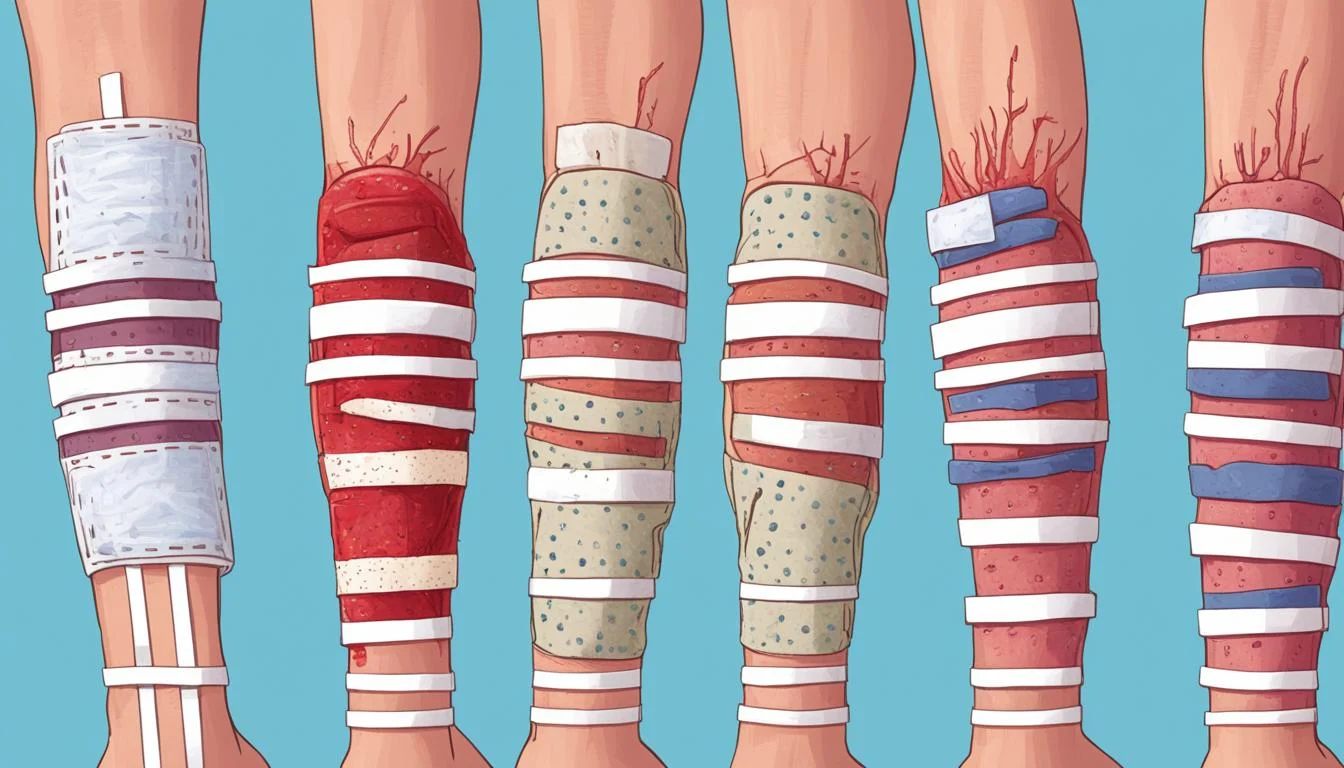
Advanced Wound Care: Biologics and Skin Substitutes
The use of biologics in wound healing brings new hope for treating complex and chronic wounds. It uses tissue engineering to develop treatments that help tissue regenerate faster and more fully. This method is evolving the way we manage wound care.
Biologics are a big step in treating wounds that don’t heal with usual methods. They include things like growth factors and engineered tissues to improve natural healing conditions. This method, along with skin substitute technology, aims to heal wounds without needing skin grafts.
Tissue engineering is changing how we deal with chronic wounds. It focuses on using cells, scaffolds, and biological factors to create new tissues. These new tissues can fit well with the skin.
- Enhanced autologous skin grafts
- Biodegradable scaffold designs
- 3D bioprinting of skin tissues
Working together, doctors can provide treatments unique to each patient using biologics in wound healing. This leads to faster healing, shorter hospital stays, and less stress for the patient.
The future of wound care relies on advances in biologics, skin substitute technology, and tissue engineering. These methods offer new healing possibilities for people all over the world.
Conclusion
The journey to understand wound care shows that a complete approach is key for healing. Both bandages and dressings help but in different ways. It’s crucial to use these tools correctly. This is vital for both patients and their caregivers.
It’s important to always keep learning about wound care. This means knowing the newest info and also respecting what works from the past. By studying first aid, professionals get better at their jobs and feel more sure of themselves.
Keeping up with new ideas is crucial in wound care. Learning never stops. It’s all about aiming for top-notch care every time. This approach helps everyone get better care.

